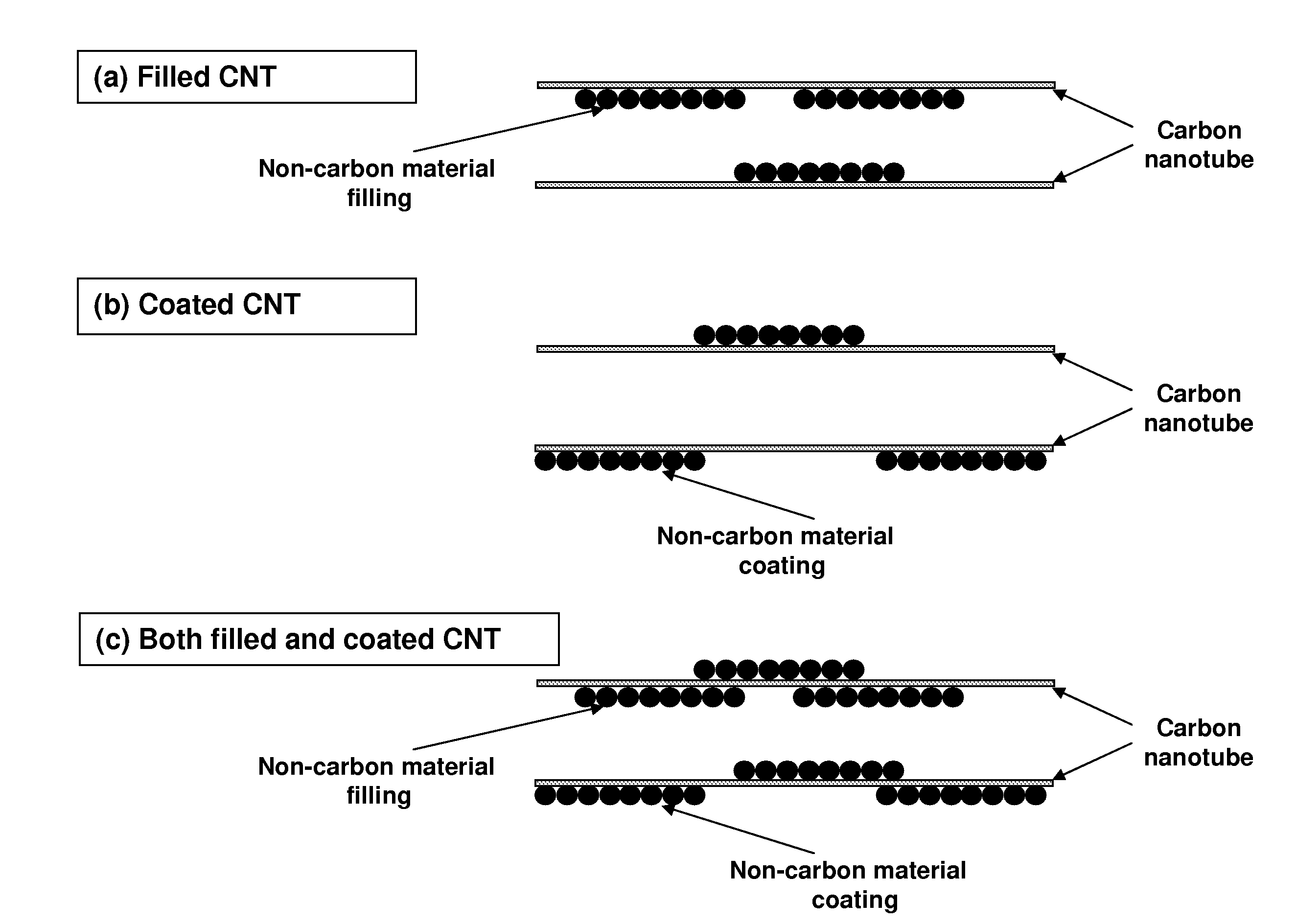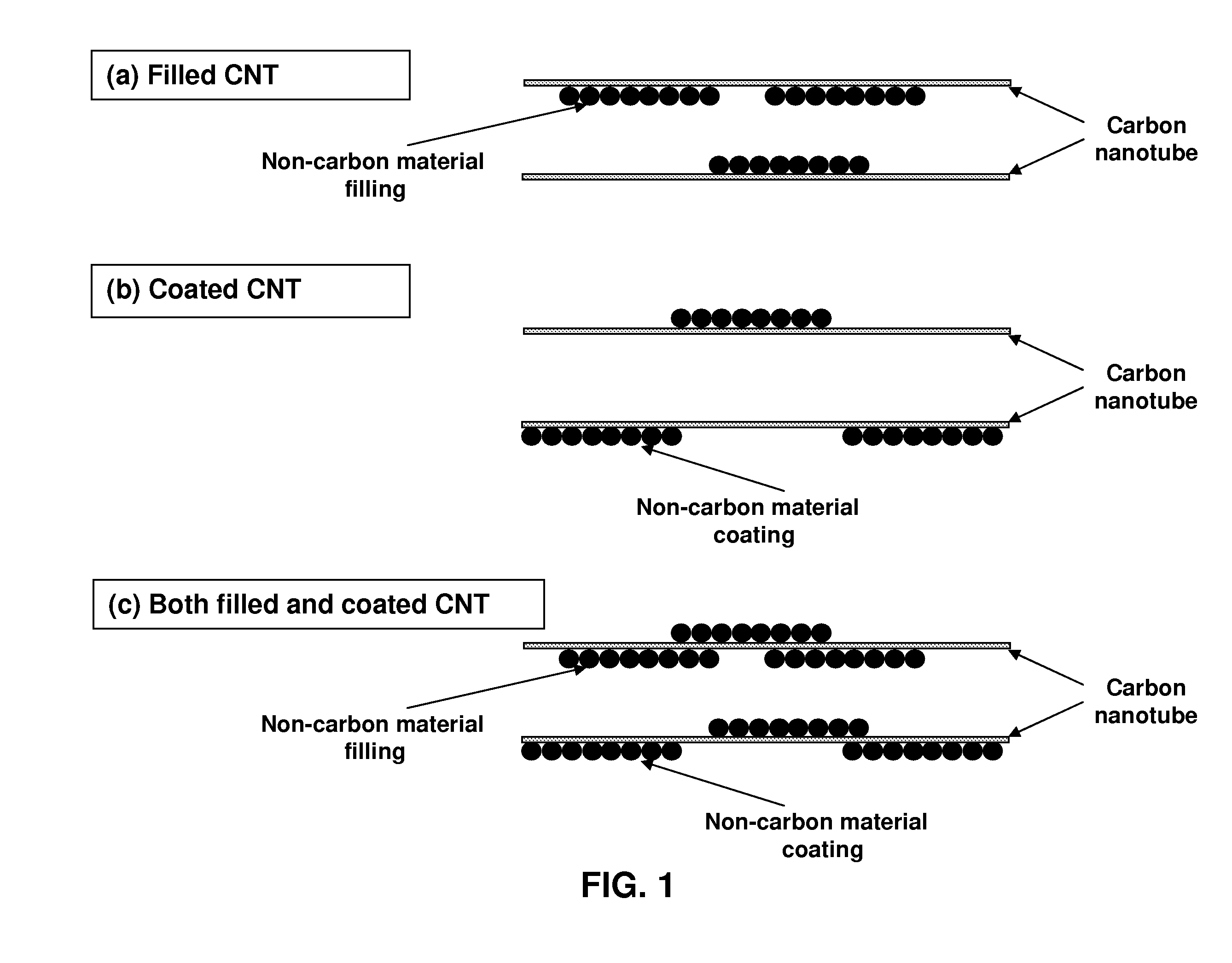Organized carbon and non-carbon assembly and methods of making
a technology of carbon and non-carbon compounds, applied in the direction of non-metal conductors, conductors, oxide conductors, etc., can solve the problems of poor electronic, thermal, chemical and mechanical properties, or articles with different properties than those targeted, and the formation of tic should be limited
- Summary
- Abstract
- Description
- Claims
- Application Information
AI Technical Summary
Benefits of technology
Problems solved by technology
Method used
Image
Examples
example 1
Ti Filled SWCNT Articles
[0168]In this example, the single-wall carbon nanotubes (SWCNTs) were filled with titanium (Ti). SWCNTs were purchased from Carbon Solutions Inc. (Riverside, Calif.) with a catalog number P2-SWNT. They were manufactured by using the arc process. These SWCNTs are designated as “starting SWCNT.” A Raman spectrum of the starting SWCNTs was obtained by using a Raman spectrometer, manufactured by Horiba Jobin Yvon (Edison, N.J.) at a laser excitation wavelength of about 633 nm. The Raman spectrum shown in FIG. 2 as a solid line had two strong signals, one at about 176 cm−1, which was caused by their radial breathing mode, and another at about 1600 cm−1, which was caused by their tangential mode and called as G band (not shown). These were typical signals for SWCNTs.
[0169]The starting SWCNTs were processed as follows. The SWCNTs, weighed about 23 mg, were placed in a 50 ml three-necked round bottom Pyrex flask, which was equipped with a heating mantle, a thermocoup...
example 2
Ti Filled SWCNT Articles
[0184]This example was carried out in the same manner as described in Example 1, except that about 82 mg of SWCNT was used instead of about 23 mg of SWCNT, 1.8 grams of TiI4 and 1.8 grams of I2 were used instead of 1 gram of TiI4 and 1 gram of I2, and that the experiment was conducted with minimal exposure to the external environment. There were only black granules, but no orange granules after the halogen removal step, indicating that an article consisting essentially of Ti filled SWCNTs was successfully obtained.
example 3
Ti Filled and Coated SWCNT Articles
[0185]In this example, the SWCNTs were both filled and coated with titanium (Ti). This example was carried out in the same manner as described in Example 2, except that the contents of the reaction flask were heated at about 275° C. for about 15 to 20 minutes prior to opening the vacuum valve and that the ethanol washing step was not carried out after the preparation of the article comprising TiI4 / I2 coated and filled SWCNTs. Thus, after the cooling of the flask, TiI4 / I2 coated and filled SWCNTs were directly placed in a quartz tube, which was inserted in a tube furnace. The Ti filled and coated SWCNTs were thereby obtained.
[0186]A micrograph of the starting SWCNT obtained by scanning electron microscopy (SEM), is shown in FIG. 3. This precursor comprised SWCNT bundles where each bundle was an aggregate of a few dozen of SWCNTs. The particles shown in this micrograph are the metal catalysts used for the SWCNT formation and growth. FIG. 4 shows an S...
PUM
| Property | Measurement | Unit |
|---|---|---|
| weight percent | aaaaa | aaaaa |
| weight percent | aaaaa | aaaaa |
| weight percent | aaaaa | aaaaa |
Abstract
Description
Claims
Application Information
 Login to View More
Login to View More - R&D
- Intellectual Property
- Life Sciences
- Materials
- Tech Scout
- Unparalleled Data Quality
- Higher Quality Content
- 60% Fewer Hallucinations
Browse by: Latest US Patents, China's latest patents, Technical Efficacy Thesaurus, Application Domain, Technology Topic, Popular Technical Reports.
© 2025 PatSnap. All rights reserved.Legal|Privacy policy|Modern Slavery Act Transparency Statement|Sitemap|About US| Contact US: help@patsnap.com



